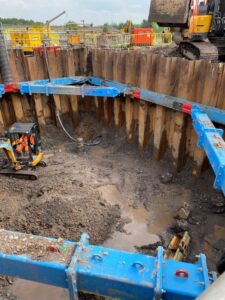Understanding Excavations and their impact on Construction
Table of Contents
Excavation Support on Site
Excavation support on site is a critical aspect of construction, particularly when dealing with deep excavations or unstable soil conditions. The primary goal of excavation support systems is to stabilize the sides of an excavation to prevent collapses, protect workers, and ensure the integrity of nearby structures and utilities. This post explores the various methods, legal requirements, and safety considerations associated with excavation support systems.
Types of Excavation Support Systems
Several types of excavation support systems are commonly used in the UK, each suited to different project requirements and site conditions:
- Sheet Piling: This method involves driving interlocking steel sheets into the ground to form a continuous barrier. Sheet piling is particularly effective in areas with high groundwater levels and is commonly used for deep excavations and cofferdams. Sheet Piling (UK) Ltd offers comprehensive services, including design, supply, installation, and extraction of sheet piles, ensuring compliance with safety regulations
- Trench Boxes and Shoring: Trench boxes are steel or aluminum structures used to support the walls of a trench. They are ideal for linear excavations, such as those required for utility installations. Shoring systems, which can be hydraulic or mechanical, provide lateral support to prevent trench walls from collapsing. Companies like Mabey Hire provide a wide range of trench boxes and shoring equipment, tailored to specific project needs
- Bracing Systems: Excavation bracing systems, such as hydraulic bracing frames, provide support for deep excavations with vertical faces. These systems can support large spans and are essential for maintaining stability in complex excavation projects. Mabey Hire offers various bracing systems, including super shaftbrace and multibrace systems, to suit different load requirements
- Soldier Piles and Lagging: This method involves driving steel H or I-beams (soldier piles) into the ground at regular intervals, with timber or precast concrete panels (lagging) placed between them to support the soil. This system is suitable for deep excavations and provides flexibility in design and installation
- Secant Pile Walls: Secant pile walls are constructed by drilling intersecting reinforced and unreinforced concrete piles to form a continuous wall. This method is used for deep excavations where groundwater control is critical and where high wall stiffness is required
Legal and Safety Requirements
In the UK, excavation support systems must comply with stringent legal and safety requirements to protect workers and the public. Key regulations include:
- Construction (Design and Management) Regulations 2015 (CDM 2015): These regulations require that all practicable steps be taken to prevent excavation collapses, including the provision of supports or battering the sides of the excavation. Excavations must be inspected by a competent person at the start of each shift and after any event that could affect their stability.
- Health and Safety Executive (HSE) Guidelines: The HSE provides detailed guidelines on excavation safety, including the need for proper planning, risk assessment, and the use of appropriate support systems. The guidelines emphasize the importance of regular inspections and the use of protective systems to prevent soil movement and cave-ins.
- Party Wall etc. Act 1996: This act requires that any excavation work within close proximity to neighboring properties be notified to the affected parties. Measures must be taken to protect adjacent buildings from potential damage caused by the excavation.

Factors Influencing the Choice of Support System
The selection of an appropriate excavation support system is influenced by several factors:
- Soil Type: Different soil types exhibit varying stability and cohesion properties, which affect the choice of support system. Cohesive soils like clay may require simpler support systems, while non-cohesive soils like sand and gravel necessitate more robust solutions
- Excavation Depth: Deeper excavations generally require more substantial support systems to prevent wall collapse and ensure stability. Systems like sheet piling and secant pile walls are often used for deep excavations
- Groundwater Conditions: High groundwater levels can complicate excavation work, necessitating the use of watertight support systems and dewatering techniques to manage water ingress and maintain stability
- Proximity to Adjacent Structures: Excavations near existing buildings or infrastructure require careful planning and robust support systems to prevent ground movement and potential damage to adjacent structures
- Project Requirements: The specific needs of the project, including temporary or permanent support, load-bearing capacity, and design life, also influence the choice of support system.
